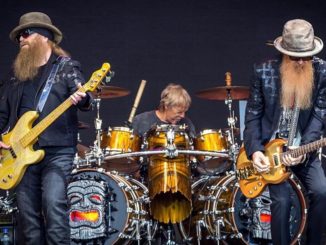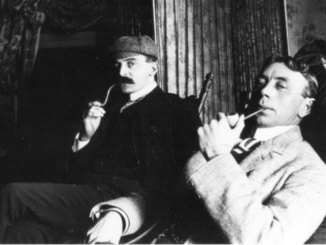Greetings pop pickers and welcome to another edition of Fabulously Flamboyant Fridays – our occasional Campari and soda drenched probe into the rainbow and glitter world of artistes who are quite simply fabulous, darling. This week we’ll be continuing our short series of articles taking a look at the halcyon days of synth pop and using my alcohol-fuelled ramblings as an excuse to post a number of fabulously flamboyant videos. And so, without further ado, laydees and gentlebodies, Fabulously Flamboyant Fridays proudly present the campest little genre in town: synth pop – part two. Not ‘arf!
I’ve described synth pop as “the campest little genre in town” and of course it did develop along those lines, but it certainly didn’t start out that way. From the emergence of Gary Numan in 1979 and for most of 1980, the nascent synth pop scene had a distinctly dystopian feel that was driven more by sci-fi tropes than by gay culture. In retrospect, it’s clear the UK’s social and political environment at that time probably played an important part in the route taken by synth pop’s early pioneers.
Between 1976 and 1980 (a period during which the foundations of the ’80s synth pop movement were laid down), Britain felt like a nation in flux: managed decline, mass unemployment, strikes, crumbling infrastructure, urban decay and of course the Cold War, with its accompanying and ever-looming threat of sudden and complete nuclear annihilation. All in all, it certainly made for what felt like a particularly gloomy period in our nation’s tale. For your humble scribe, things seemed to come to a head towards the end of 1978. This was the time when the UK government’s policy of wage increase limits began to be challenged seriously by trade unions in what became known as ‘The Winter of Discontent’. During this period of widespread mass strikes, held over the winter of ’78 and ’79, there were genuine fears that British society was beginning to fray and was in danger of descending into serious civil unrest.
Against this thoroughly gloomy social and economic background, it is perhaps understandable and certainly unsurprising that our young synth pop pioneers should feel some sense of doom and alienation, and would therefore look to the possibilities (both optimistic and pessimistic) offered up by contemporary cinematic and literary visions of the future. We have already considered the importance of the soundtrack to Kubrick’s dystopian masterpiece A Clockwork Orange and the BBC’s earlier and groundbreaking theme for the Dr. Who television series. However, the link between both literary and cinematic sci-fi and popular electronic music probably goes back a little further than that.
As far as the film industry is concerned, the use of electronic music in soundtracks probably began with the use of the theremin to produce suitably eerie and otherworldly sounds. If you are unaware of the theremin, it’s a very odd electronic instrument that is played without the performer actually touching it. It was invented by Leon Theremin in 1919 and usually consists of two metal antennae that function as positional sensors. Each antenna forms one half of a capacitor, with the player’s hands forming the other half of the two capacitors. One controls pitch, the other controls volume. The soundtrack of The Day the Earth Stood Still (1951) is a very good example of it’s use in film, but if you want to see some serious theremin action, you need look no further than the remarkable work of <a href=”https://youtu.be/PjnaciNT-wQ”>Grégoire Blanc</a>. You can also see Bill Bailey using one of these instruments at the start of his Kraftwerk routine in the video that wrapped up part one of this series.
The film Forbidden Planet (1956) is where we take the next step in our tale, as this was the first major film to be accompanied by a soundtrack that consisted entirely of electronic sounds. This was a revolutionary soundtrack, although to be honest it contains little that could actually be described as music. Instead it is a collection of electronic bleeps, bloops, hums, drones and whistles that are used to produce a series of futuristic and otherworldly electronic soundscapes.
Nevertheless, despite its lack of music, the soundtrack to Forbidden Planet proved to be highly influential on the work of composers and creators in the sci-fi field. The use of electronic sound effects and electronic music in TV and cinema continued to develop through the ’50s and 60’s, until by the 1970s we arrive at the groundbreaking and hugely influential work of Wendy (then Walter) Carlos and the work of composers such as Giorgio Moroder and John Carpenter. The influence of Carlos and Moroder on the development of synth pop simply cannot be overstated. However, we shall not dwell here upon the importance of their work. Their contributions to the development of synth pop have been adequately explored in previous editions of Fabulously Flamboyant Fridays, so we shall instead pay tribute to the mid-70’s work of the American director and composer, John Carpenter, whose synth-driven soundtracks also played an important part in the development of 1980’s synth pop.
Carpenter is most commonly associated with horror, action, and science fiction films. His early work included critical and commercial successes such as Halloween (1978), Escape from New York (1981), and Starman (1984). However, a number of his other projects – in particular his early work from the ’70s – have come to be considered as highly influential cult classics. A perfect example of this can be found in Carpenter’s dystopian 1976 film, Assault On Precinct 13. Details of the plot need not detain here, but what does matter to our tale is the film’s soundtrack. Carpenter frequently composed and performed the soundtracks to his films, and in 1976 his synth work – clearly ahead of its time – was heralding the arrival of a synth pop era that was still, at that point, some three or four years into the future. Carpenter’s main theme for Assault On Precinct 13 is a perfect example of this – it is simply crying out for a Gary Numan vocal track before its subsequent inclusion on an album by Tubeway Army.
But it wasn’t just cinema that was an influence on synth pop; dystopian and sci-fi literature was also playing its part. Orchestral Manoeuvres In The Dark have name checked George Orwell’s 1984 as an influence on their work, and they even named their drum machine ‘Winston’ after the novel’s central character. Incidentally, OMD were originally known as ‘The Id’, a name inspired by the Freudian “monsters from the id” that featured so prominently in the film Forbidden Planet.
The work of the late-British author JG Ballard also proved to be a significant inspiration for the development of the UK’s synth pop scene. His dystopian 1973 novel, Crash, which explores the psycho-sexual merger of technology, sexual dysfunction and death through the eyes of vehicle crash survivors, casts a long shadow over the work of many of synth pop’s early pioneers. Ballard’s novel was the inspiration for landmark compositions in the development of synth-pop such as Warm Leatherette (1978) by The Normal, Cars (1979) by Gary Numan and Metamatic, the debut solo album from John Foxx. The Human League, in contrast, were far less highfalutin in their sci-fi influences. Originally called ‘The Future’, when the band decided they needed a change of name, they took their inspiration from a group of characters in a sci-fi board game called Star Force: Alpha Centauri and accordingly re-named themselves as ‘The Human League’.
And so we arrive at 1980 and the first full year of high profile synth pop success in the UK. Gary Numan was the primary synth pop star of 1980 with 4 hit singles: Cars, We Are Glass, I Die You Die and This Wreckage. John Foxx decided to leave his band (Ultravox) to embark on a solo career and, as noted above, produced the synth-pop album Metamatic and three Crash-inspired hit singles: Underpass, No One Driving and Burning Car. Ultravox took the loss of John Foxx in their stride, recruited Midge Ure as his replacement and had almost immediate success with their synth-pop hit Sleepwalk. 1980 also saw the breakthrough of synth pop duo, Orchestral Manoeuvres In The Dark, who produced two hit singles – Messages and Enola Gay.
The Buggles also deserve a special mention here. They were synth-pop pioneers with their 1979 hit Video Killed The Radio Star and had two minor follow-up hit singles in 1980 with The Plastic Age and Clean Clean. However, although The Buggles were soon to disappear (they merged with the shattered remnants of ’70s prog-rock superstars Yes and managed to prop up the old lags for long enough to produce one more studio album), they would still have a huge impact on the development of synth-pop. During his time with The Buggles and Yes, founder member Trevor Horn developed into a hugely gifted recording engineer, studio boffin, and record producer. His innovation and success in these fields would lead to him being described as “the man who invented the ’80s”. However, although we shall acknowledge his substantial contribution to 80’s music in general and to synth pop in particular, we shall not dwell upon his studio shenanigans here, because, as is the case with Moroder and Carlos, we have already explored his activities in some detail during a previous episode of Fabulously Flamboyant Fridays.
Other notable synth pop successes in 1980 included Yellow Magic Orchestra (Computer Game), Spandau Ballet (To Cut A Long Story Short), Visage (Fade To Grey) and Jon & Vangelis with their soppy but somewhat charming I hear You Now, which in truth owed as much to the hippy-drippy early ’70s as it did to the synth pop movement of the ’80s.
However, as 1980 was drawing to a close, so too was the bleak, dystopian, sci-fi driven version of synth pop. The Human League, one of the UK’s principle pioneers of synth pop, were finally getting their act together, affordable synths were beginning to move into the production of dance and club music and a second wave of synth pop acts began to build their digital dance floor fillers upon the bleak concrete foundations laid down by 1980’s initial wave of dystopian synth pop pioneers.
Anyway, that’s yer lot for this week’s episode of Fabulously Flamboyant Fridays. In part three of this series we’ll move from sci-fi to a more soulful scene, as we take a look at the magnificently camp glory years of synth pop; and we’ll wrap things up for tonight with a wonderful cover of my favourite track from synth pop’s dystopian period: Daniel (The Normal) Miller’s groundbreaking and hugely influential JG Ballard-inspired 1978 composition, Warm Leatherette, performed here by two of my favourite musicians: Trent Reznor (Nine Inch Nails) and Peter Murphy (Bauhaus).
TTFN Puffins – Not ‘arf!
Featured Image: Alberto Garcia, CC BY-SA 2.0, via Wikimedia Commons
© Ivory Cutlery 2023



